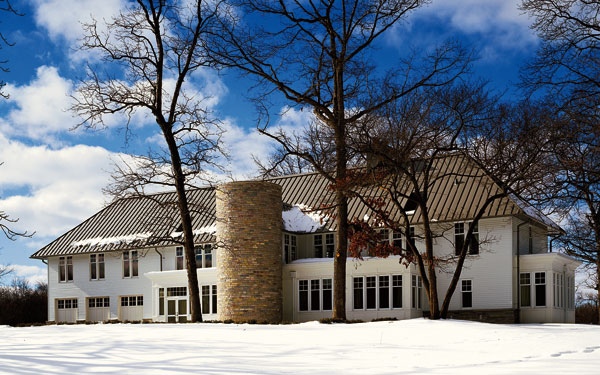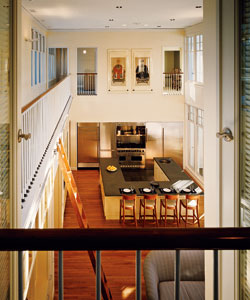 |
|
At first glance, you might mistake this new house, with its hipped roof and stone "silo", for a romantic old barn. It sits on the high point of 32 acres, with the property sloping gently down to a meadow on this side and a pond on the other. Photo Gallery::: |
Once upon a time, there was another Lake Forest-one dotted with barns, stables, and extraordinarily well-groomed dairy herds. Bert Meers was born far too late for that gilded age of gentleman’s farms, but he did grow up riding his bike past their elegant remains. So when he and his wife, Kris, bought a piece of open land in Lake Forest, they began planning a house that would remind them of those beautiful old outbuildings.
Then one day, another compelling option presented itself. On a trip to South Carolina, the pair fell in love with Charleston’s "single houses," the 18th-century houses-each just a single room wide-that march in parallel formation from the city’s waterfront, their narrow ends facing the street, their lengths bedecked with verandas. "We told Hanno how much we loved those Charleston houses," says Bert, recalling the day they confessed their conflict to their architect, Hanno Weber, "and he told us how brilliant we were."
Asked to combine a Midwestern hayloft with a colonial rowhouse, another architect might have thrown an artistic tantrum. But Weber, who once won a grant to study early American cities, was enchanted by the possibilities. He envisioned not some Frankenstein mash-up of the two styles, but an architectural love child that could both highlight the property’s Waldenesque views and accommodate the Meers family’s relaxed lifestyle.
Weber explains that pre-revolutionary South Carolina merchants adopted the single house’s long, narrow profile as a way of evading British real estate taxes-calculated by measuring a home’s street frontage and tallying up the number of rooms. Verandas didn’t count in the tax equation, so incidental spaces like hallways evolved into the elongated al fresco rooms that festoon the outside of the single houses. "In Charleston that piazza (pronounced pee-AHH-zah in South Carolinian) was a corridor; here it is a destination," Weber says.
 |
|
The master bedroom opens out over the great room via louvered doors. A U-shaped island defines the kitchen area, where glass doors open onto the enclosed piazza. "Spaces leak into each other and connect back to the middle," says Weber. Photo Gallery::: |
And an extremely popular destination at that. Boisterous family parties are a way of life for Kris, Bert, Sarah (20), and Katy (18), and the house’s enclosed piazza, facing pond and sunset, sets up perfectly for those multi-generational meals. "Kathleen measured every inch of this porch to make sure we could seat 60 people for dinner," says Kris, referring to Kathleen Hess, interior designer at Hanno Weber & Associates. "The first time we gave a big party, she faxed the caterers about where the tables should be set up." Hess didn’t draw the client service line at table placement, either. She flew to New York to meet Kris and personally test the dining chairs the two had chosen, to be sure guests would be as happy with their seats as with the setting.
So what happened to Bert’s notion of calling forth the ghosts of the old farms? Weber didn’t forget. The hip-roofed house is covered in a clapboard siding that rises above a ruggedly old-fashioned stone foundation. Silhouetted against oaks, pond, and sky, the house looks every inch the picturesque old Lake Forest barn. Weber even designed a stone "silo" that emerges from a prairie meadow on the east side of the house. The silo hides a romantic winding staircase to the second floor, an architectural detail as striking as any piece of sculpture. Weber notes that he especially loves the way the stairway doesn’t intrude into the great room, the airy, two-story family room/kitchen that is the home’s hub.
"Angles of light stream in from everywhere," Bert says. "The colors and shapes of things change in relationship to each other throughout the day." The furniture can change relationships, as well. "Every room is distinct, but everything mixes together," notes Hess, who chose the chairs and tables so they could move from room to room.
"Have you noticed how many places we have gray leather?" asks Bert, pointing to the soft, subtle leather that covers a bench, library chairs, and even coasters and wastebaskets, weaving continuity through the home’s open floor plan. "This is a 21st-century version of my mother’s good taste," says Bert, whose late mother was a legendary grande dame in a town that knows a grande dame when it sees one.
In the kitchen, everything has been designed for flexibility and informality. Pantry cabinets appear magically from hidden wall niches, a foot pedal operates a sink for hands-free rinsing, and utensil drawers slide open from either side of the U-shaped island. "I can unload the dishwasher from one side and set up the island for dinner from the other," marvels Kris. Hess laughs as she recalls how Kris once called her from Florida and simply said, "Tell me about horsehair." The kitchen stools were upholstered soon after in that party-friendly, virtually indestructible material.
"It’s all about family," says Kris.
"And dogs," Hess adds.
The Meerses’ rambunctious yellow Labrador, Max, and lively Jack Russell terrier, Lily, are in and out of the pond so often that Hess designed a dog shower for the laundry room. Sarah and Katy love hanging out on the piazza, and are forever popping through one of the ten doors that lead into the great room. "They open all the doors and yell," says Bert. "There’s a feeling of freedom here." Maybe not as much freedom as tearing around old farms on your bike, but pretty darn close.
For information on resources, see Buyer’s Guide.
Related:


